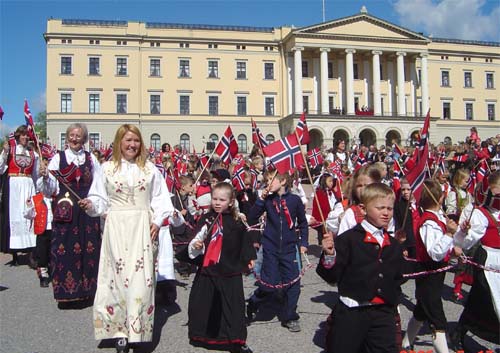by Susan Flantzer
© Unofficial Royalty 2024

The Children’s Parade in Oslo in 2010; Credit – By evelinagustafsson@live.se – Own work, Public Domain, https://commons.wikimedia.org/w/index.php?curid=10407995
In Norway, May 17 is Constitution Day and the National Day of Norway. The celebrations focus on Norway as an independent state governed by the rule of law with democratic rights for all. Unlike other countries’ National Days, Norway’s National Day is not celebrated with military parades, but with local children’s parades in which music bands and school children march together.
History

The Norwegian Constituent Assembly meeting at Eidsvoll, Norway in 1814 by Oscar Wergeland; Credit – Wikipedia
The Constitution of Norway was adopted on May 16, 1814, and signed on May 17, 1814 by the Norwegian Constituent Assembly at Eidsvoll, Norway. The constitution declared Norway an independent kingdom in an attempt to avoid being ceded to Sweden after Denmark-Norway‘s defeat in the Napoleonic Wars. The attempt failed and Norway was part of the United Kingdoms of Sweden and Norway until 1905.
The first celebration of May 17th took place in Trondheim in 1815, one year after the Constitution was drafted and adopted. The French-born Jean-Baptiste Bernadotte who was elected Crown Prince of Sweden in 1810 by the Riksdag, the Swedish parliament, ruled over Norway and Sweden from 1818 to 1844 as King Karl III Johan of Norway and King Carl XIV Johan of Sweden. He regarded the May 17th celebrations and Norway’s independent Constitution as revolutionary acts against Sweden. In 1828, celebrations of Constitution Day were prohibited. However, his son and successor King Oscar I of Sweden and Norway had a different opinion. Starting in 1845, the year after he became King, Oscar I attended the May 17th celebrations, and greeted the parade from the royal estate, now called the Royal Palace of Oslo.
In Norway, holidays and festivals were often celebrated by parades with banners, music, and singing. Peter Qvam, a school headmaster, came up with the idea of holding a children’s parade, Barnetog (children’s train). In 1869, the first Barnetog was held on May 17th with about 1,200 boys participating. Girls began participating in 1889.
What Happens?
Bunads

Credit – Av Ingen maskinlesbar opphavsperson oppgitt. Leifern er antatt opphavsperson, basert på opplysninger om opphavsrett. – No machine-readable source provided. Own work assumed (based on copyright claims)., CC BY-SA 2.5, https://commons.wikimedia.org/w/index.php?curid=371104
It is common for Norwegians to wear bunads on May 17th. The term bunad refers to clothes designed in the early 20th century, loosely based on traditional costumes. Bunads are often worn at folk dances, weddings, baptisms, confirmations, Christmas, and graduations.
Children’s Parades

A kindergarten class with their class banner marching in a children’s parade; Credit – By Ranveig Thattai – Ranveig Thattai, Public Domain, https://commons.wikimedia.org/w/index.php?curid=162695
Children’s parades, Barnetog in Norwegian which translates to children’s train, are organized in Norwegian communities and many communities where Norwegians live abroad. In Norway, each elementary school district arranges its own parade with marching bands between schools. The children are dressed festively and carry small Norwegian flags. The children’s parades vary in size from tens of people in small villages to several tens of thousands of participants in Oslo, Norway’s capital.
The children’s parades follow certain routes in towns and are organized so that the children walk by class behind their school banner. Many classes also have their own homemade banners. The parade ends with children and adults gathering in a large space where speeches are given. After the speeches, many people join the parade on the march back to the starting point. Some communities also have separate citizens’ trains or people’s trains where everyone can participate.

The Children’s Parade in Oslo going past the Royal Palace in Oslo; Credit – By Morten Johnsen – Own work, CC BY-SA 3.0, https://commons.wikimedia.org/w/index.php?curid=1514702
In Oslo, about 70,000 children and adults and 1,700 bands march in the children’s parade. The Staff Band of the Norwegian Armed Forces leads the Oslo children’s parade. The parade passes the Royal Palace where the royal family wave from the palace balcony.
The Royal Family on the Balcony of the Royal Palace in Oslo
Left to Right: Princess Ingrid Alexandra, Prince Sverre Magnus, Crown Prince Haakon, Crown Princess Mette-Marit, Queen Sonja, and King Harald V wave Norwegian flags from the balcony of the Royal Palace in Oslo, on May 17, 2021
Each May 17, the Norwegian royal family gathers on the balcony of the Royal Palace in Oslo to greet the Oslo children’s parade. King Haakon VII and Queen Maud began the tradition in 1906 and subsequent monarchs have continued the tradition. There have been two exceptions. Queen Maud’s father King Edward VII of the United Kingdom died on May 6, 1910, and the Norwegian royal family was in mourning and attending the funeral in the United Kingdom. Norway was under German Occupation during World War II from 1940 – 1945. During the occupation, Norwegians were forbidden to celebrate May 17th, participate in parades, or use the colors of the Norwegian flag on clothes.
Crowds gather in front of the Royal Palace during the Norwegian Constitution Day celebrations on May 17, 2014 in Oslo, Norway
This article is the intellectual property of Unofficial Royalty and is NOT TO BE COPIED, EDITED, OR POSTED IN ANY FORM ON ANOTHER WEBSITE under any circumstances. It is permissible to use a link that directs to Unofficial Royalty
Works Cited
- Bidragsytere til Wikimedia-prosjektene. (2005, May 19). Norges nasjonaldag. Wikipedia.org; Wikimedia Foundation, Inc. https://no.wikipedia.org/wiki/17._mai_(grunnlovsdag)
- Celebrating May 17th. (2020, May 17). Royalcourt.no. https://www.royalcourt.no/nyhet.html?tid=78630&sek=27262
- Constitution Day (Norway). (2022). Wikipedia. https://en.wikipedia.org/wiki/Constitution_Day_(Norway)
